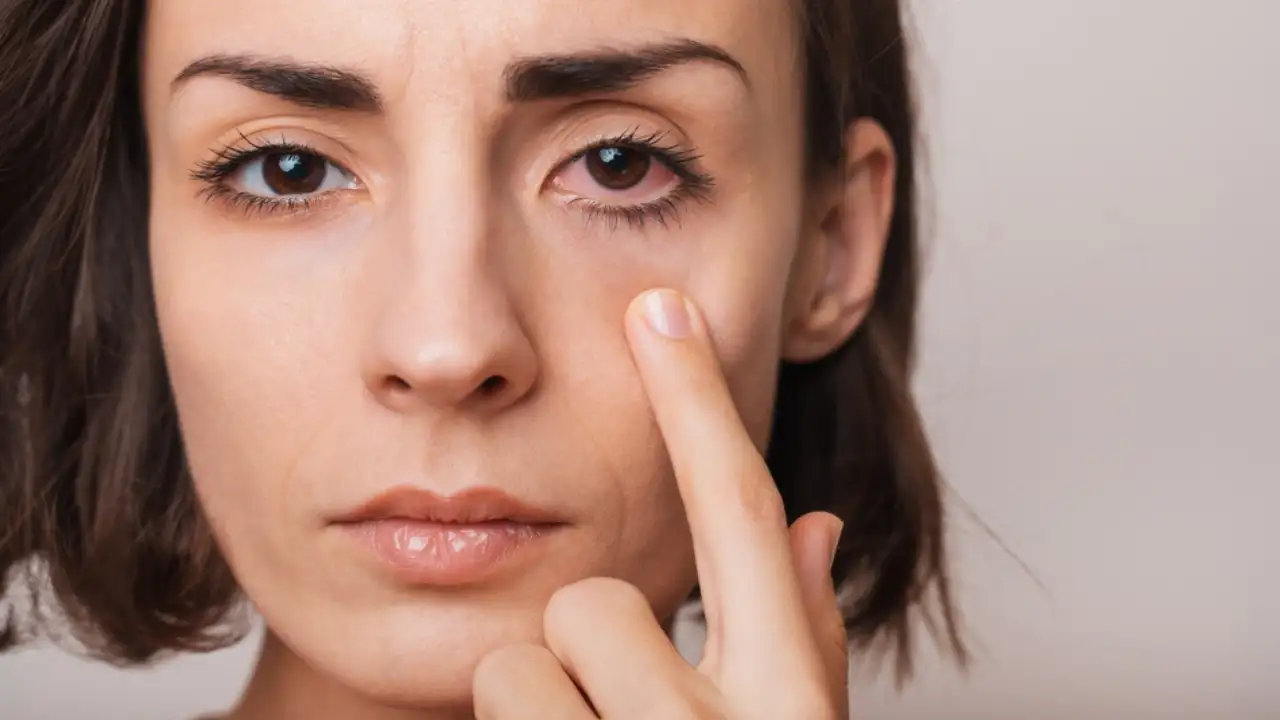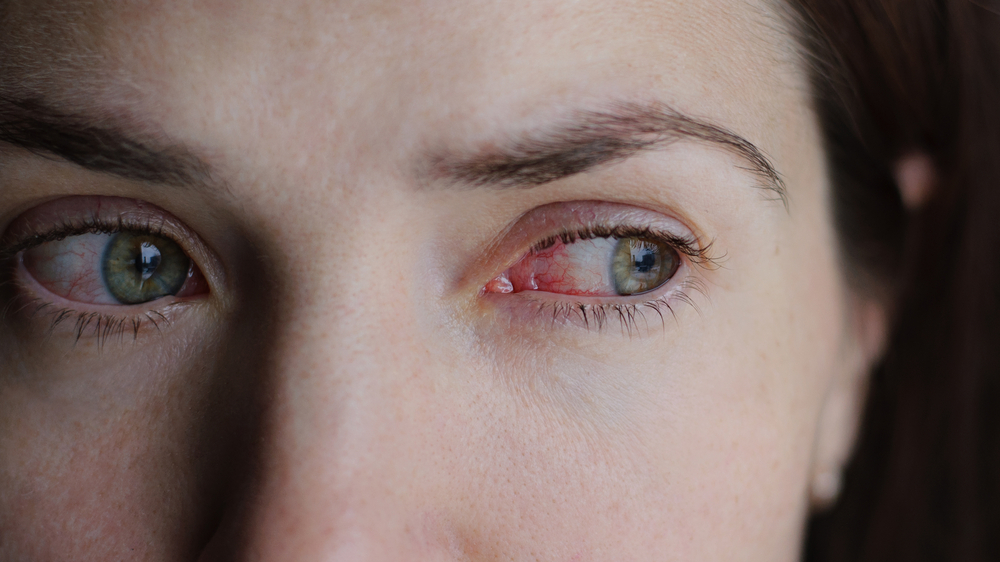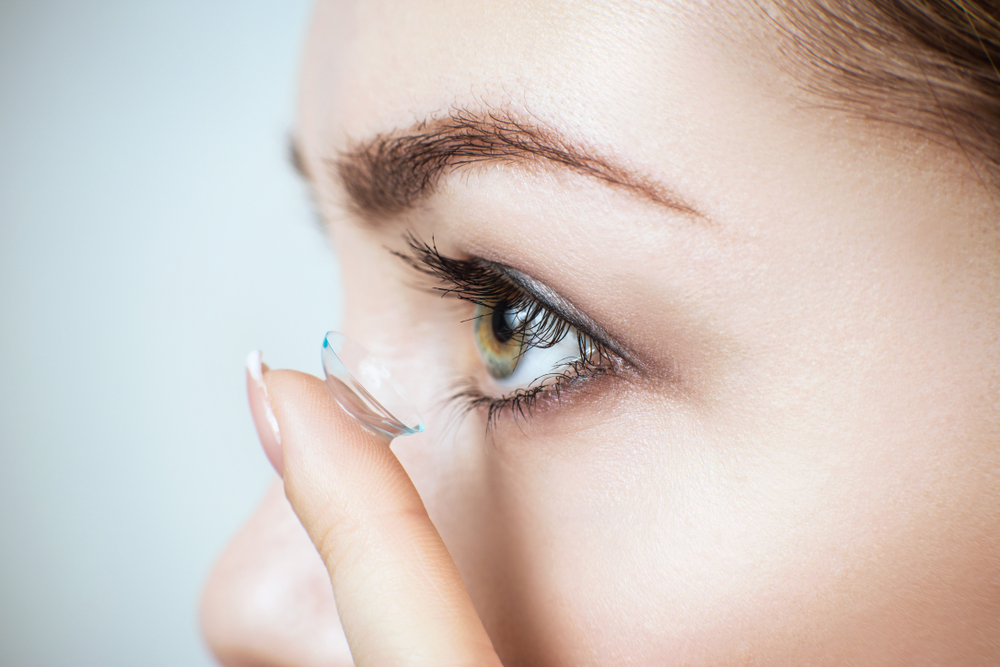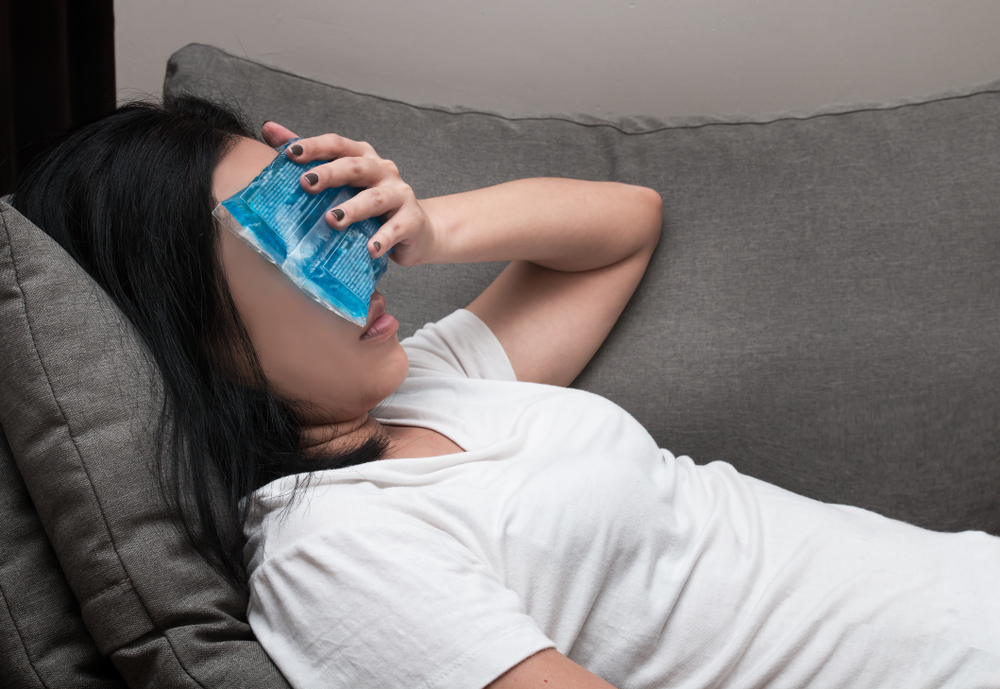Are Red, Sore Eyes Bothering You? Learn How to Get Rid of Red Eyes Here!
One fine day you wake up and your eyes are red, swollen, burning, irritated! There has to be a way to fix it quickly! Learn how to get rid of red eyes here!

For those of us blessed with the sense of sight, we rely on it heavily in our day-to-day life. In fact, it’s considered the most valued sense of all. An online survey reported that on average, participants would choose 4.6 years of life in perfect health instead of 10 years of life with no vision (1). So, when our eyes are sore and red, it can be quite bothersome to get on with simple, everyday tasks.
In this article, we’ll cover what causes red eyes, how to get rid of red eyes, home remedies to get rid of red eyes, how to prevent it, when it’s a cause for alarm, and if you should visit an ophthalmologist. But, before we begin, let’s engage in a short little practice to give it some rest from our screens and everyday stresses.
Ready?
- Step 1: Find a calm corner or spot in your house or in your general surroundings.
- Step 2: Play some calming music to soothe your nerves and senses. Alternatively, you may also listen to some healing guided meditations.
- Step 3: Close your eyes and take a few deep breaths.
- Step 4: Massage your eye socket bones down to the bridge of the nose with your middle finger to improve blood circulation.
- Step 5: Repeat the process 10 times.
- Step 6: With your index and middle finger pressed together, draw a sideways 8 across your eyes, almost like tracing an infinity knot.
- Step 7: Repeat the step 10 times.
- Step 8: Finish the practice with a mindful prayer to set the tone for the rest of the day.
We hope the practice gave your hard-working eyes the much-needed respite they deserve. Now, let’s move on to the causes of red eyes.
Bloodshot Red Eyes - What are the Causes?
Waking up to eye redness can immediately be concerning but most of the time it’s generally harmless. Here are some of the most common reasons why your eyes may be red (2):
1. Conjunctivitis

Conjunctivitis is the inflammation of the conjunctiva which is the mucous membrane covering the front of the eye and the lines inside the eyelids. When conjunctivitis occurs, an inflammatory process occurs on the ocular surface wherein blood vessels are widened, there is cellular infiltration accompanied by a watery and slimy discharge. Conjunctivitis is often characterized by bloodshot red eyes, swelling of the conjunctiva, increased tear production, eyelids stuck together upon waking up after a nap, itching, a sensation, or irritation.
There are 3 types of conjunctivitis:
a) Bacterial Conjunctivitis:
Any infectious conjunctivitis is typically considered a bacterial one. It is typically caused by staphylococci, streptococci, or pneumococcal bacteria. Bacterial conjunctivitis is typically marked by red eyes, a mucus-like secretion, and yellowish crusting on the eyes. It may sometimes also be accompanied by an ear infection.
b) Viral Conjunctivitis:
As the name suggests, viral conjunctivitis is highly contagious. It typically begins in one eye and passes on to the other one. Unlike bacterial conjunctivitis, a viral one is marked by a watery secretion and severe itching. Viral infections are primarily caused by a herpes simplex virus and tend to be seasonal. Those affected are also likely to suffer from a tear overflow and light sensitivity.
c) Allergic Conjunctivitis:
Allergic conjunctivitis is mainly caused by immunoglobulin-E-reactive antigens. They are antibodies produced by the immune system. If you’re suffering from an allergy, the immune system overreacts to the allergen by producing immunoglobulin-E. The antibodies then travel to the cells that release chemicals, thereby causing an allergic reaction. Allergic conjunctivitis is marked by excessive tear production, swollen and red eyes, and itching.
2. Dry Eyes
According to a study, dry eye or dry eye disease (DED) occurs in 5% to 35% of people around the world (3). DED is an inflammatory disease marked by a foreign body sensation, redness, stinging, burning, irritation, itching, and light sensitivity. DED mainly occurs when your tear ducts can’t produce enough tears and when your tears dry up too quickly. It affects the layers of tears that cover your cornea.
3. Contact Lens Problems

Those who rely on contact lenses heavily may often see eye redness. It may cause complications such as a hazy appearance over the cornea, microcysts, abrasions, damage to the cells of the cornea’s outer layer, and bacterial infections, among other things (4). All of these problems can make the eyes become red.
4. Foreign Particles in the Eye
External irritants and pollutants like dust and minuscule flyaway particles can get lodged in the eye, especially on windy days. When one is unable to locate the particle on time or is unaware of its positioning, it can irritate the eyes and make them red.
5. Orbital Cellulitis
This kind of infection affects the fat and the muscles around the eyes and can occur at any age but is primarily seen in children (5). It is mostly caused by bacteria and causes red eyes, swelling of the skin around the eyes, bulging eyes, pain in opening and closing the eyes, and sometimes even blurred vision.
When to See a Doctor for Red Eyes?
If home remedies don’t provide you with the results you’re looking for, it’s best to see a doctor for the following:
- If the eye infections persist for more than a week.
- If the mucus, pus, and crusting don’t reduce in 4 days.
- If you are overly sensitive to light.
- If there is a noticeable change in your sight.
- If you see wavy lines, flashes, or experience loss of vision.
- If the redness doesn’t reduce.
- If the swelling only seems to be increasing.
- You have severe headaches and feel sick.
Note: It is best to not try home remedies for children under 3.
How to Get Rid of Red Eyes Fast! 10 Home Remedies that Offer Sweet Relief!
- Cold or Warm Compress

Take a thick yet soft piece of cloth, preferably cotton, and soak it in a clean bowl of water. Squeeze the excess water off the cloth and place it over your eyes to give it some cool relief. Repeat the process several times a day. Don’t have a clean piece of cloth at home readily available? Don’t worry, you can also use an ice pack instead. Alternatively, you can also try the same method with warm or lukewarm water. Make sure that the water is not boiling or hot.
- Use a Humidifier
Humidifiers can be life-changing appliances when used correctly. They release water vapor or steam to increase the moisture levels in the air. Place a humidifier in the room you use most and even dryness in the air surrounding could cause or aggravate red eyes.
- Change Your Pillowcase Every Day
If you’re wondering how to treat red eyes, sometimes the answer is as simple as making a few tweaks to your lifestyle. When we are fast asleep, we toss and turn around. This means that we’re leaving crusty flakes on our pillowcase along with other germs and bacteria, none of which is going to help hasten the healing process. So, invest a few extra pillowcases and change them every day till your red eye problem goes away. Ensure that you also keep your sheets and blankets clean.
- Butterfly Pea Flower

You may have already enjoyed several cups of butterfly pea in the form of soothing and rejuvenating tea. It’s considered a healing plant owing to its antibacterial and anti-inflammatory properties. To use butterfly pea flower, crush it and mix it with cow’s milk to form a thin paste and apply it over your eyes. Let it sit for 5 minutes and wash it off with clean, cold water.
- Tea Bags
If you’ve been collecting different flavors of tea bags, it’s time to put some of them to good use and use it as a red eye treatment. It’s not only a great way to reduce the redness in your eyes; it’s also a relaxing way to unwind and tune the world out. Some teas such as green and chamomile tea are known for their anti-inflammatory and soothing qualities. Placing wet tea bags over your eyes for 10 minutes may help reduce inflammation, swelling, and fight eye redness.
- Cucumber Slices
Another great way to unwind after a long day and get rid of red eyes simultaneously is to place a thin slice of cucumber on your eyes. Cucumber has high water content which helps keep the eyes cool and the skin hydrated. It also boasts anti-inflammatory qualities and provides relief from skin irritation. While you’re at it, here’s a quick cucumber skin mask recipe. Blend half a cucumber and 2 tablespoons of yogurt in a blender to form a paste. Apply it to your face for 10 minutes and see glowing results.
- Say No to Screen Time
It may not seem like a big deal but taking some much-needed time away from your screens and digitally detoxing may sometimes be the only solution you need to cure red eyes.Unregulated screen time may even be the cause of eye redness in the first place. This break is especially necessary for children as research has shown that longer screen hours hamper a child’s healthy development (6).
- Use a Vaporizer
One of the primary suspects for a red eye is dryness and it can make your eyes feel itchy and irritated. If you suffer from seasonal allergies, along with bouts of sneezing, you’re also likely to see red eyes. To tackle this problem, spending 5 minutes using a vaporizer and giving your face and eyes that soothing jet of steam can help reduce red eyes. The gentle steam from the vaporizer helps clear out nasal and air passages to clear out all the junk stuck in them and help enable better and easier breathing. Ensure that you’re not keeping your face dug into the vaporizer and use it only for 5 minutes at one go.
- Water

One of the easiest and safest home remedies is splashing your eyes with water. Use room temperature water and splash your eyes in quick succession several times. Repeat the process thrice a day for quicker results. Alternatively, you can also use your palms curled up to form a cup and fill it with water. Place your eyes into the cup of your palms and blink inside the water as many times as you can or till the water trickles out.
- Aloe Vera
Aloe vera is considered one of nature’s most healing remedies and the same is the case for red eyes. Because of its anti-inflammatory properties, it helps reduce swelling and offers a cool and soothing sensation to get redness in the eyes. Mix equal parts of pure aloe vera gel and water to form a runny paste. Soak cotton pads in the mixture and place them over your eye for 30 minutes.
We’re hopeful that one out of these 10 effective red eye treatments and remedies will set you on the path to recovery and beautiful, clear eyes. But, here are also some tips for you to prevent red eyes.
How to Prevent Red Eyes
- If you’re a big fan of makeup, go ahead and explore your artistic talent but ensure that you wipe away everything properly before bed time. Use high-quality products and products that are especially suitable for your skin type.
- Try getting natural, fresh air as much as possible and avoid sitting directly under the AC for long periods as it can dry your eyes out.
- Don’t rub your eyes with your hands, especially if they haven’t been washed in a few hours. Instead splash some clean water in your eyes.
- This goes without saying, but, follow good hygiene practices.
- Keep your contact lenses clean and try not to sleep with them on. Use prescription glasses instead.
- Reduce screen time and if that’s not an option, take regular breaks to give your eyes some rest. Additionally, massage your eyes at regular intervals.
What a pain it is, isn’t it when our eyes are irritated, burning, itchy, and red. Even when it’s a common and curable problem, we can’t help but think out loud, “I should have wiped off my eyeliner before bed”; “I shouldn’t have kept my contact lenses on so long”; “I should have taken breaks from my screen” etc,. The “I should” and “I shouldn’t” have can be endless and there’s no point playing the self-blame game when we already have red eyes. So, for the next, be careful and take care of yourself. Until then, these 10 home remedies on how to get rid of red eyes will set you on your way.
Sources:
1. An online survey reported that on average, participants would choose 4.6 years of life in perfect health instead of 10 years of life with no vision.
Evaluating Whether Sight Is the Most Valued Sense
https://www.ncbi.nlm.nih.gov/pmc/articles/PMC6777262/
2. Some of the most common reasons why your eyes may be red.
Red Eye: A Guide for Non-specialists
https://www.ncbi.nlm.nih.gov/pmc/articles/PMC5443986/
3. According to a study, dry eye or dry eye disease (DED) occurs in 5% to 35% of the people around the world.
The Pathophysiology, Diagnosis, and Treatment of Dry Eye Disease
https://www.ncbi.nlm.nih.gov/pmc/articles/PMC4335585/
4. It may cause complications such as a hazy appearance over the cornea, microcysts, abrasions, damage to the cells of the cornea’s outer layer, and bacterial infections, among other things.
Contact Lens–Related Problems and Complications
https://www.ncbi.nlm.nih.gov/books/NBK587443/
5. This kind of an infection affects the fat and the muscles around the eyes and can occur at any age but is primarily seen in children.
Orbital Cellulitis
https://www.ncbi.nlm.nih.gov/books/NBK507901/
6. This is especially necessary for children as research has shown that longer screen hours hamper a child’s healthy development.
Screen time and developmental health: results from an early childhood study in Canada
https://bmcpublichealth.biomedcentral.com/articles/10.1186/s12889-022-12701-3





 JOIN OUR WHATSAPP CHANNEL
JOIN OUR WHATSAPP CHANNEL
















































